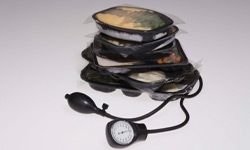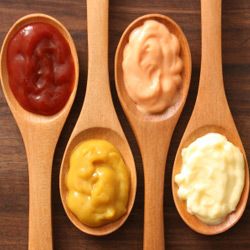By: Tom Scheve

Most of us have heard we should watch our sodium intake, but with our growing awareness of the role it plays in high blood pressure, few of us think of sodium as something that's essential to life. It helps muscles contract, assists nerve impulses and plays a part in the proper maintenance of fluid levels.
However, it doesn't take a lot of sodium to accomplish its biological mission, and more sodium doesn't translate to additional benefits. The U.S. Department of Health and Human Services recommends we consume 1,500 to 2,400 milligrams (mg) of sodium -- about one teaspoon of salt -- at most each day.
Advertisem*nt
But some foods that we frequently eat have a lot more sodium than we realize. What are they? Keep reading to find out.
Contents
- Frozen Diet Meals
- Dairy Products
- Condiments
- Canned Veggies
- Bread
5: Frozen Diet Meals

Frozen dinners are a busy person's dream food. While they once consisted primarily of country-fried steak and potatoes, now there's a wide variety to choose from, including frozen meals for those looking to cut calories. While these quickie diet meals are low in carbs and fat, they're also commonly loaded with sodium and may still leave you craving a midnight snack.
When choosing a frozen diet meal, be a label reader. Check the serving size and number of servings, because your dinner may be meant for two. Look for a dinner with no more than 500 to 800 mg of sodium, and remember to counter-balance your sodium intake for the rest of the day with healthier fruits and veggies.
Advertisem*nt
Next up: Does milk do a body bad?
4: Dairy Products
Dairy products have a good rep: They help children grow, contribute to strong bones and teeth, and are an excellent source of calcium and vitamin D. But most people don't realize that dairy products can run with a rough crowd.
One cup of low-fat milk has about 107 mg of sodium, and one slice of American cheese has around 310 mg. Now, think about the half-dozen slices you ordered on your sub sandwich.
Advertisem*nt
And though cottage cheese is touted as a great diet food, it's brimming with sodium. A half-cup serving has around 450 mg. So what happens if you eat an entire tub in one fell swoop? Yikes, sodium overload!
Keep reading to learn how a little sauciness isn't always a good thing.
3: Condiments

Once you've selected healthy food that's low in sodium, you'd think you'd be out of the woods, but you'd be wrong. Because once you sit down to eat your healthy selection, you'll likely add a little extra. And that's often how sodium winds up on your plate, despite your best efforts.
Condiments -- such as ketchup, soy sauce and teriyaki sauce -- can pack a surprising sodium punch:
Advertisem*nt
- 1 tablespoon teriyaki sauce: 690 mg
- 1 tablespoon soy sauce: 1,000 mg
- 1/2 cup spaghetti sauce: 600 mg
- 1 tablespoon ketchup: 178 mg
- 1/4 cup co*cktail sauce: 69 mg
Look for low-sodium condiments, and try to switch to lemon juice or vinegar for flavor when you can. Choose low-salt and no-salt pasta sauces, and your blood pressure will thank you.
Next up, those cans may be convenient, but they pack a salty punch.
2: Canned Veggies
There are lots of good things about canned vegetables: They're rich in vitamins and nutrients, they're easy to prepare and they last practically forever. But many canned goods are high in sodium, including soups and chili. In fact, one can (officially 2.5 servings) of chicken noodle soup has more than 2,500 mg of sodium. But the sodium in a half-cup serving of canned vegetables can be surprising:
- Sliced carrots: 370 mg
- Chopped kale greens: 330 mg
- Zucchini: 490 mg
- Cream-style corn: 365 mg
- Diced tomatoes and green chilies: 520 mg
Try rinsing your canned veggies before eating: This won't get rid of all the sodium, but it will reduce it. And look for labels that boast, "No salt added." Best yet, eat fresh vegetables instead.
Advertisem*nt
Next: Bad news for bread-heads.
1: Bread
Sliced bread is what makes most of our lunches possible, but bread isn't salty, is it?
Most commercial bread has more than 100 mg of sodium per slice, and many rolls, specialty breads, bagels and muffins have as much as 300 to 400 mg. So how can bread-heads satisfy their addictions without overdosing on sodium?
Advertisem*nt
Look for low-sodium substitutes. You can do your body right by choosing a bread that's whole-grain, low-sodium and produced without excess sugars or fats.
Mix it up in the mornings with a breakfast that's less bread-intensive (sans toast, waffles, pancakes, muffins and bagels). At lunch, make your sandwich a regular two-slicer instead of a three-slice club.
Continue reading for lots more information on high-sodium foods.
Baking Soda and Powder
One reason bread has surprisingly high levels of sodium is that baking soda and baking powder have high sodium content. While baking soda has many useful functions (such as regulating pH balance and leavening bread), a quarter-teaspoon of it has 300 mg of sodium. Whether baking at home or purchasing baked goods, use (or search for products containing) low-sodium versions of baking soda.
Lots More Information
Related Articles
- 5 Delicious Low-sodium Soups
- 5 Low-sodium Cheeses
- 5 Sodium Myths Debunked
Sources
- ABC News. "Beware of Hidden High-Sodium Foods." Good Morning America. Aug. 1, 2006. (Nov. 3, 2010)http://abcnews.go.com/GMA/OnCall/story?id=2259909&page=1
- Bennett, Bev. "Reducing the high sodium content of condiments." Philadelphia Inquirer. Oct. 7, 2010. (Nov. 4, 2010) http://www.philly.com/philly/health_and_science/CTW_health_20101007_Reducing_the_high_sodium_content_of_condiments.html
- Briggs, Helen. "Call for Mandatory Salt Curbs." BBC News. Nov. 1, 2010. (Nov. 4, 2010)http://www.bbc.co.uk/news/health-11666377
- CBS News. "What to Seek, Avoid in Frozen Diet Meals." The Early Show. Feb. 20, 2010. (Nov. 4, 2010)http://www.cbsnews.com/stories/2010/02/20/earlyshow/main6226470.shtml
- The Coca-Cola Company. "Nutrition Connection." 2009. (Nov. 3, 2010)http://productnutrition.thecoca-colacompany.com/products/coca-cola-zero
- Gazzaniga, Donald A. and Maureen A. Gazzaniga. "The No-Salt, Lowest-Sodium Light Meals Book." Thomas Dunne Books. 2005.
- Huget, Jennifer LaRue. "Dietary Guidelines may reduce allowance for salt and sodium." The Washington Post. Nov. 4, 2010. (Nov. 4, 2010)http://www.washingtonpost.com/wp-dyn/content/article/2010/11/01/AR2010110106078.html
- Huget, Jennifer LaRue. "Is 1,500 mg of sodium a realistic goal?" The Washington Post. Nov. 2, 2010. (Nov. 4, 2010)http://voices.washingtonpost.com/checkup/2010/11/is_1500_mg_of_sodium_a_realist.html?sid=ST2010110204277
- Mayo Foundation for Medical Education and Research. "Sodium: How to Tame Your Salt Habit Now." May 22, 2010. (Nov. 4, 2010)http://www.mayoclinic.com/health/sodium/NU00284
- Nestle, Marion. "How Ultra-Processed Foods Are Killing Us." The Atlantic. Nov. 4, 2010. (Nov. 4, 2010)http://www.theatlantic.com/food/archive/2010/11/how-ultra-processed-foods-are-killing-us/65614/
- Salt, Alec N., Ph.D. "Sodium Content of Common Foods." Washington University. (Nov. 3, 2010)http://oto2.wustl.edu/men/sodium.htm
- SMI Analytical Laboratory Services. "Calories and Nutritional Information about our Food: Candy." (Nov. 3, 2010)http://www.smianalytical.com/food-nutritional-values/calories-fat-food.php?calories=CANDY&pgn=1
- WebMD. "Salt Shockers Slideshow: High-Sodium Surprises." Nov. 17, 2008. (Nov. 4, 2010)http://www.webmd.com/diet/slideshow-salt-shockers
Cite This!
Please copy/paste the following text to properly cite this HowStuffWorks.com article:
Citation
Advertisem*nt
Advertisem*nt
Loading...
\n\n\t\t\t\t
`;t.byline_authors_html&&(e+=`By: ${t.byline_authors_html}`),t.byline_authors_html&&t.byline_date_html&&(e+="|"),t.byline_date_html&&(e+=t.byline_date_html);var i=t.body_html.replaceAll('"pt','"pt'+t.id+"_");return e+=`\n\t\t\t\t
\n\t\t\t\t
\n\n\t\t\t\t
${i=i.replaceAll("#pt","#pt"+t.id+"_")}
\n\n\t\t\t
`}(a);this.loadedDiv.innerHTML+=n,document.title=a.title+" | HowStuffWorks";let s="content-loaded-"+a.id,l=document.getElementById(s);l.dataset.contentId=a.id;let o=l.querySelectorAll(".lazyload");HSW.utilities.lazyLoadElements(o),HSW.ux.editorial.init({twitter:!0,facebook:!0,instagram:!0}),l.querySelectorAll(".toc a").forEach(t=>{t.addEventListener("click",t=>{t.preventDefault();let e=t.target.dataset.target,i=document.querySelector("a[name='"+e+"']");i?i.scrollIntoView({behavior:"auto"}):console.error("Unable to locate target with name "+e)})});try{if(userData.adsActive)if(HSW.utilities.isMobile()){l.querySelectorAll(".ad-mobinline").forEach(t=>{t.setAttribute("id","ad-wrap-mobinline"+r),t.childNodes[0].setAttribute("id","ad-div-mobinline"+r),void 0!==HSW.ads&&HSW.pq.add(()=>{HSW.ads.addNewUnits(["ad-div-mobinline"+r])},"ads"),r++})}else{let t=document.createElement("div");t.setAttribute("id","ad-after-"+e),t.classList.add("ad-inline","mb-8","bg-gray","w-max-full","h-min-90","text-center");let a=document.createElement("div");a.setAttribute("id","ad-div-inline"+i),t.appendChild(a),l.after(t),void 0!==HSW.ads&&HSW.pq.add(()=>{HSW.ads.addNewUnits(["ad-div-inline"+i])},"ads")}}catch(t){console.error(t)}if(window.setupSinglePageUX(l),history.pushState)try{history.pushState(null,a.title+" | HowStuffWorks",a.href)}catch(t){console.warn(t)}var c=[];a.taxonomy.forEach((t,e)=>{c[e]=t.title.toLowerCase()});var d=c.join("/"),h=[];a.authors.forEach((t,e)=>{h[e]=t.first_name.toLowerCase()+" "+t.last_name.toLowerCase()});var g=h.join(",");pageMetricsData.href=a.href,pageMetricsData.title=a.title,pageMetricsData.tax=d,pageMetricsData.aType=a.asset_type,pageMetricsData.cType=a.type+"-continuous",pageMetricsData.template=a.template,pageMetricsData.source=a.source,pageMetricsData.sponsor=a.sponsor,pageMetricsData.author=g,pageMetricsData.contentid=a.id,pageMetricsData.image=a.hero_image,pageMetricsData.page=0,pageMetricsData.pubDate=a.publish_date.slice(0,10),pageMetricsData.editDate=a.last_editorial_date.slice(0,10);const u=/[^\da-z_]/i;let p=HSW.utilities.isMobile()?"hsw_lite":"hsw";a.taxonomy.slice(1,3).forEach((t,e)=>{p+="|"+t.title.replace(u,"").toLowerCase()}),pageMetricsData.adUnit=p,Alpine.store("share",{title:pageMetricsData.title,url:pageMetricsData.href,image:pageMetricsData.image}),function(t,e){let i=t.href.split(".com/").pop();dataLayer.push({event:"virtual-page-view",virtualPageUrl:i,virtualPageTitle:document.title,pageNbr:0}),dataLayer.push({event:"raw-event-interactive",eventCategory:"page-interaction",eventAction:"continuous-load",eventLabel:"new-content",eventValue:e+1,virtualPageUrl:t.href})}(a,this.items.length);const m={...pageMetricsData};t.items.push(m);for(var f=document.getElementsByClassName("new-content-loaded"),v=0;v